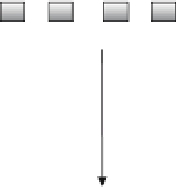Biomedical Engineering Reference
In-Depth Information
maintained at temperatures below 50
◦
C (such as room temperature). The
hydrogel becomes soft and recovers its un-deformed original shape, which
is predetermined by the covalent network, upon increasing the temperature
above 50
◦
C [128]. Even though the concept is appealing, the use of this type
of hydrogel is limited because the transition temperature is not commensu-
rate with the body temperature.
Another class of hydrogels that demonstrate shape memory consists of
a spatially modulated blend of two different hydrogels with different proper-
ties [302, 303]. For instance, when a bi-gel strip consists of temperature sensi-
tive PNIPAm hydrogel and temperature insensitive polyacrylamide hydrogel,
temperature increases causes it to bend. This change in shape is reversible
and the gel can switch between the two shapes depending upon the exter-
nal temperature. Such modulated hydrogels could be used to create various
reversible shapes such as alphabets, numbers, wavy structures, and ribbon-
like structures (refer to Fig. 8). Hydrogels of this nature could potentially be
used to fill irregularly shaped defects in the biomedical field. However, one of
the major concerns about these shape memory hydrogels is their weak me-
chanical properties and researchers are seeking to find tougher modulated
polymers.
Recently, Lendlein et al. created a series of responsive shape memory
polymers which are mechanically tough, biocompatible, and biodegradable,
applicable to a number of biomedical applications [300, 301, 305]. Such shape
memory polymers are achieved by copolymerizing precursors with differ-
ent thermal characteristics such as the melting transition temperature. These
shape memory polymers can be deformed into a temporary compressed
state and they can recover the permanent shape only with the aid of an ex-
ternal stimulus such as temperature. This type of shape memory polymer
mainly consists of two components: (i) molecular switches—precursors that
can undergo stimuli responsive deformation and can fix the formed tempo-
Fig. 8
Schematic of a shape memory modulated gel exhibiting different shapes depending
upon the external stimuli















